This pesto sauce combines fresh basil leaves with pine nuts, olive oil, Parmesan cheese, and a touch of salt for an out-of-this-world flavor! Pesto is an easy-to-make base for so many wonderful pasta meals, dips, dressings, and much more! This traditional old-world Italian sauce blends with cooked pasta for a quick 10-minute dinner any night of the week!
Pesto Sauce - Pesto alla Genovese
While this traditional pesto sauce was originally made with a mortar and pestle in Genoa, Italy, it now comes together in just minutes with a food processor! This tasty fresh basil pesto sauce is absolutely perfect for quick pasta dinners, pizzas, dips, salad dressings, and more!
Plus, it's an extremely versatile sauce to use with meats. Marinate steak, pork, chicken, or fish in your homemade pesto sauce, or use it to season Italian-inspired meatloaf or meatballs!
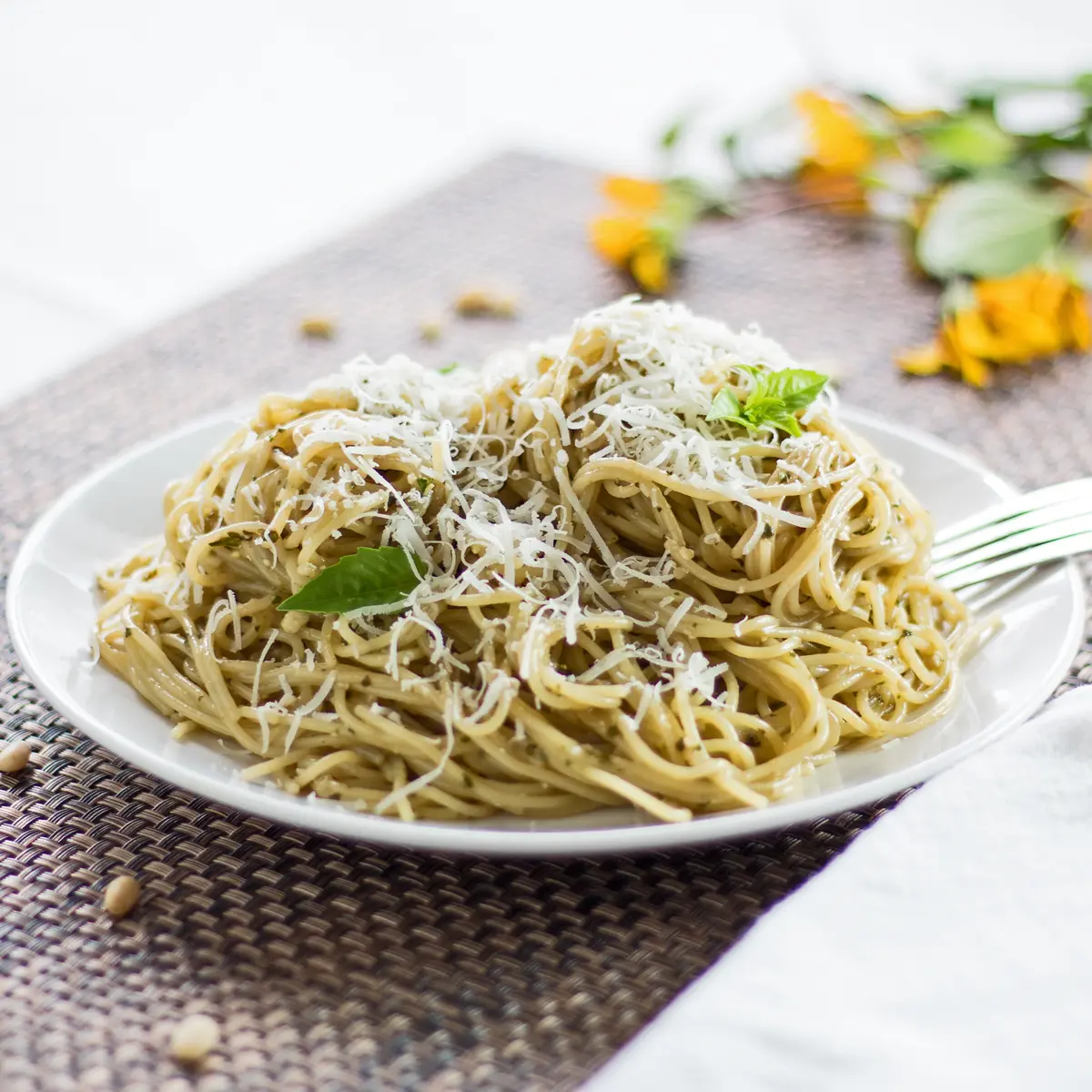
Jump to:
🥘 Pesto Sauce Ingredients
You'll only need a handful of basic ingredients to make this fantastic sauce! If you need any alternatives to the pine nuts or dairy, I've included instructions below!
- Pine Nuts - 2 tablespoons of pine nuts.
- Garlic - 2 large cloves.
- Olive Oil - Use ½ cup of good quality extra virgin Italian olive oil.
- Parmesan cheese - ½ cup of freshly grated Parmesan cheese.
- Fresh Basil Leaves - 2 cups of fresh basil leaves (approximately 2 ounces, young basil leaves are best).
- Salt - 1 pinch salt (to taste).
*Be sure to see the free printable recipe card below for ingredients, exact amounts & instructions with tips!*
🔪 How To Make Pesto Sauce
My favorite method of making my pesto sauce holds off on adding the basil until the end, that way the pesto sauce retains that vibrant green color from the fresh basil. Go ahead and take out some measuring utensils and a food processor to get started.
This recipe will make approximately 6 servings! You can always double or triple the recipe as needed.
- Combine. To get started, combine 2 tablespoons of pine nuts (also called piñón, pinoli, or pignoli) and 2 large garlic cloves in your food processor.
- Blend. Pulse the food processor until the pine nuts and garlic have reached a finely minced texture.
- Add oil. With your food processor on the lowest speed setting, slowly drizzle ½ cup of extra virgin olive oil into the minced nuts and garlic. Combine on low speed until your sauce reaches a smooth consistency.
- Add ingredients. Add ½ cup of freshly grated Parmesan cheese along with two cups of fresh basil leaves (young, fresh Genovese basil is traditionally used and is favored by Italian foodie fans).
- Pulse sauce. Pulse your food processor in short bursts, just enough to combine the ingredients.
- Add salt. Add a pinch of salt, stir it into the pesto, and adjust to taste as needed.
This tasty pesto sauce is extremely versatile and can be used in a variety of dishes like pizza, pasta, salads, sandwiches, and more! Try it on a chicken breast with pesto chicken marinade, then serve your pesto chicken with cream cheese pasta and oven garlic bread! Enjoy!
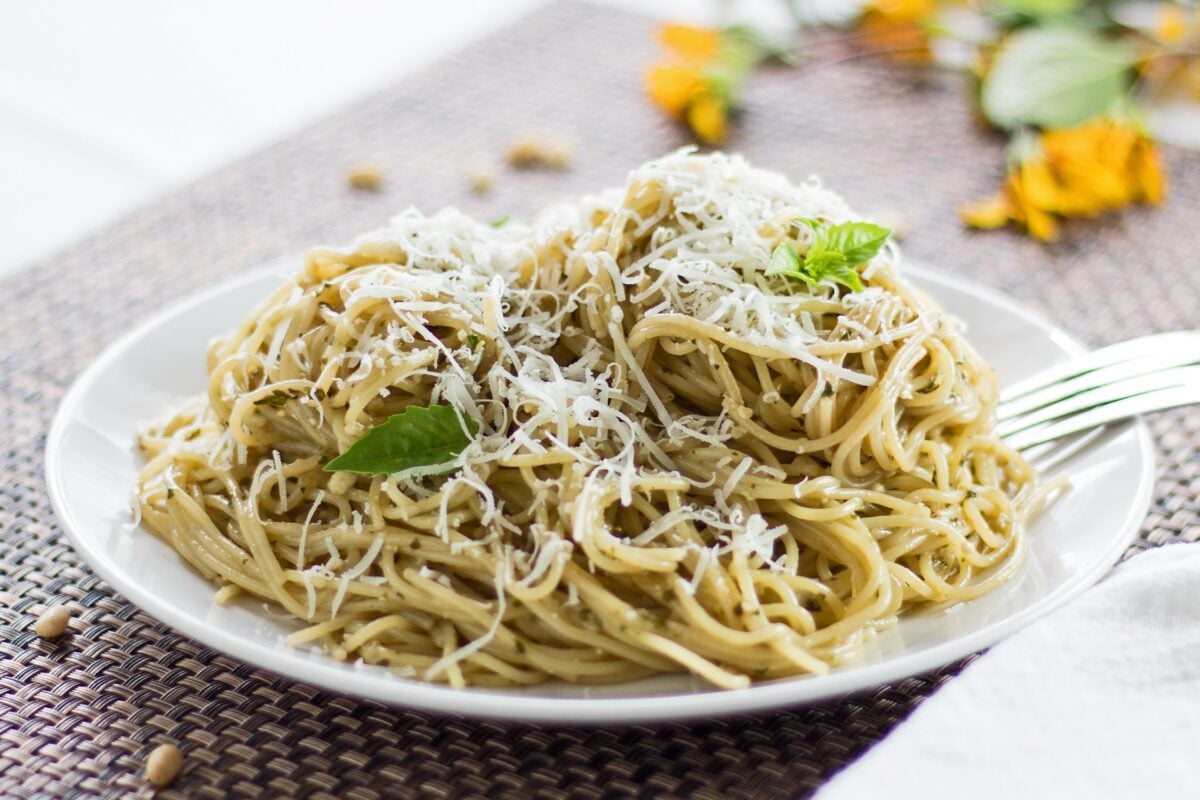
🧂 Substitutions & Additions
If you are needing to substitute pine nuts or dairy, take a look at some alternatives you can use instead!
Pine Nut and Nut-Free Alternatives
European pine nuts (sometimes toasted) are traditionally used in pesto alla genovese, however, other nuts can be used. My personal favorite runner-up to pine nuts in pesto sauce is walnuts. I always have them on hand, which makes mixing up pesto on the fly a snap.
Other nut varieties that could be used in pesto sauce include almonds, pistachios, pecans, macadamia nuts, sunflower seeds, pumpkin seeds, peanuts, cashews, Brazil nuts, or sesame seeds.
To make pesto without pine nuts or any nut variety, simply omit any nut ingredient. The basil will still be vibrant, fresh, and delicious!
Parmesan and Dairy-Free Alternatives
To substitute for Parmesan cheese, the best choices for a classic pesto flavor are other hard Italian cheeses such as Romano, Asiago, Pecorino, Machego, Grana Padano (the closest Parmesan cheese flavor substitute). Readily available cheeses here in the states can also be used, such as a good aged sharp or extra sharp cheddar, preferably white cheddar.
While hard cheese is typically used in pesto, experimenting with softer cheeses has been done by many. It won't give you the same familiar pesto consistency, but you may find you love your favorite cheese as part of your homemade pesto sauce. Have fun and be creative!
For those with, or cooking for someone with, dairy allergies you can simply omit the cheese entirely. The basil and nuts combine to make a fantastic sauce with or without any cheese element.
💭 Angela's Tips & Recipe Notes
- Using fresh ingredients is key to achieving the best flavor results! This sauce relies heavily on fresh basil, so make sure your basil leaves are bright green and fragrant.
- You can toast the pine nuts in a dry pan over medium heat to add an even more nutty flavor to the sauce. Stir frequently and heat until the nuts turn golden brown.
- Make sure to not overmix the pesto sauce as it should have some texture. Also, when you add the Parmesan cheese at the end, pulse lightly so that the sauce doesn't become gloopy.
- Adjust ingredients as needed, especially the salt. If your sauce is too salty, add more pine nuts or cheese. If your sauce is too thick, you can add a little more olive oil.
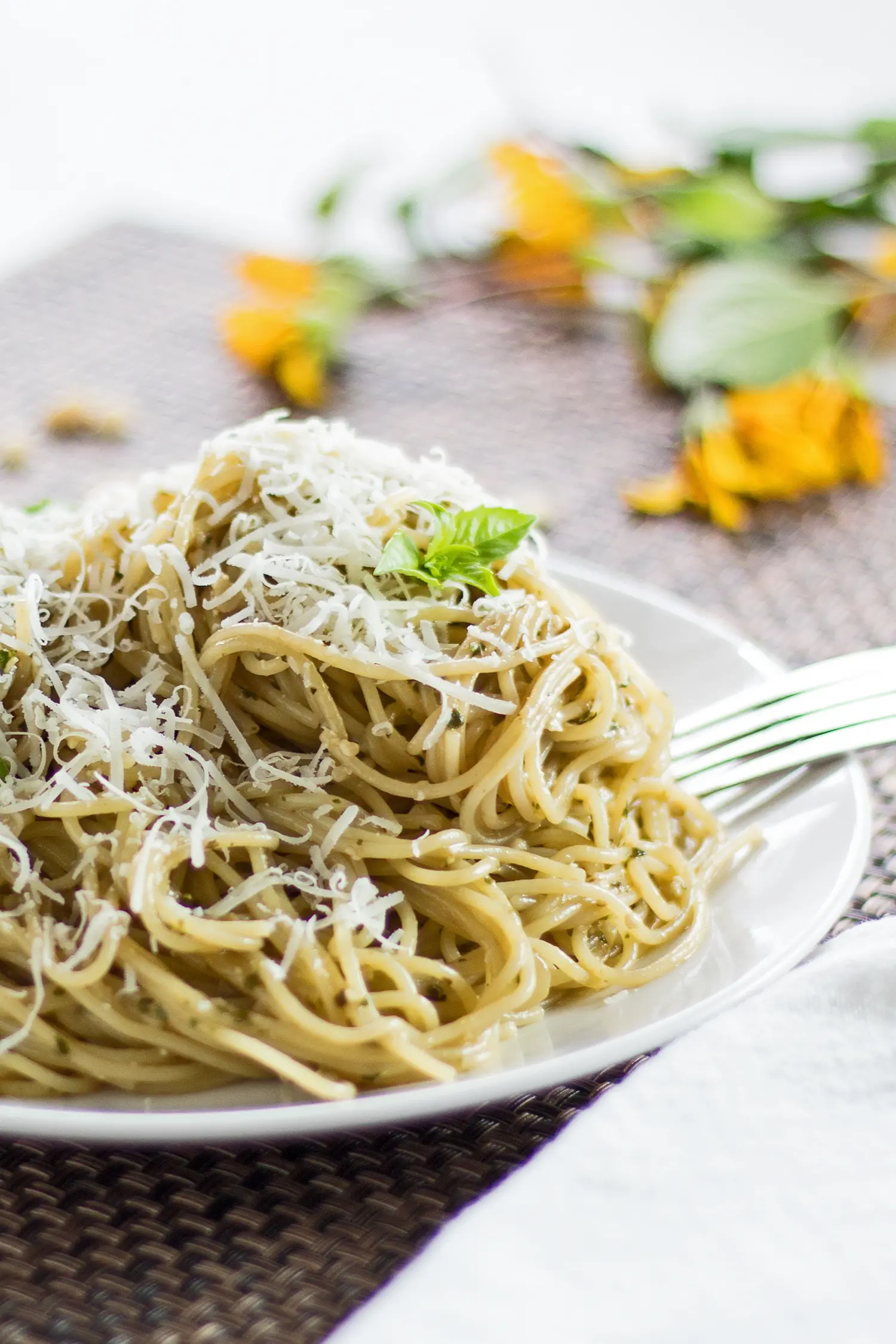
🥡 Storing
To store your classic pesto sauce in the refrigerator, transfer the sauce to a jar or air-tight container. Pour a thin layer of extra virgin olive oil over the pesto sauce, or place a piece of plastic wrap directly onto the surface of your pesto sauce. This will keep the cut basil in the sauce from oxidizing and turning brown.
Homemade pesto will last for up to a week in the refrigerator but is best used within the first half of the week.
Freezing Pesto Sauce
The same applies to freezing your pesto. To keep the pesto vibrant and fresh-looking when you use it later, transfer the pesto to a jar and fill it approximately ¾ full. Cover with a thin layer of extra virgin olive oil. Seal tightly with the screw-on lid, then freeze for up to one month.
You can also transfer the homemade pesto to small snack-size Ziploc plastic storage bags. Squeeze all of the excess air out of the storage bags and seal them securely. These will also keep in the freezer for about one month.
>>>>See all of my recipes here<<<<
❓ Recipe FAQs
Absolutely! You can substitute pine nuts with other nuts like walnuts, almonds, or pistachios. You could even use sunflower seeds or pumpkin seeds if you'd like!
Yes! Pesto sauce can be frozen for later use. It's best to freeze it in an airtight container, a sealable jar, or in ice cube trays and then transfer it to a heavy-duty freezer bag. Thaw your sauce in the fridge before using it.
😋 More Amazing Sauces
- Arrabbiata Sauce - This flavorful Italian sauce is tomato based and has a spicy kick!
- Ponzu Sauce - Ponzo sauce is a versatile Japanese sauce that can be prepared in just 5 minutes!
- Tzatziki Sauce - If you're a fan of Mediterranean food, then you must try this easy homemade Tzatziki sauce!
- Chicken Wing Sauce - To make the best wings at home, you'll need this incredibly zesty and tangy wing sauce recipe!
- Hawaiian BBQ Sauce - This wonderfully tasty BBQ sauce has sweet, salty, and savory flavors!
- Teriyaki Sauce - My homemade teriyaki sauce is a tasty blend of soy sauce, orange juice, brown sugar, garlic, ginger, and more!
Do you love a recipe you tried? Please leave a 5-star 🌟rating in the recipe card below and/or a review in the comments section further down the page.
Stay in touch with me through social media @ Pinterest, Facebook, Instagram, or Twitter! Subscribe to the newsletter today (no spam, I promise)! Don't forget to tag me when you try one of my recipes!
📖 Recipe Card
Basil Pesto Sauce {Pesto alla Genovese}
Ingredients
- 2 tablespoon pine nuts
- 2 large cloves garlic
- ½ cup olive oil
- ½ cup Parmesan cheese (freshly grated)
- 2 cups fresh basil leaves (approximately 2 oz, young basil leaves are best)
- 1 pinch salt (to taste)
(Note: 2x or 3x only changes the ingredient list)
Instructions
- Combine pine nuts and garlic in a food processor and process until very finely minced.
- Leave your food processor on low speed and drizzle the olive oil into the minced ingredients. Combine until the mixture is smooth.
- Add the grated Parmesan cheese and basil leaves then pulse the food processor in short bursts, just enough to thoroughly combine the sauce ingredients. Season with a pinch of salt, stir, and adjust to taste as needed.
Notes
To serve your pesto on cooked pasta: transfer the cooked al denté pasta to a serving bowl using tongs or a pasta fork ( the saucepan or pot used to boil the pasta will be too hot for the fresh basil pesto ). Add your pesto sauce to the pasta, then add some of the pasta water in spoonfuls bit by bit. Stir between each addition to combine and emulsify the sauce. This recipe will use about ¼ cup of the pasta water to make your perfect pesto pasta!
- Using fresh ingredients is key to achieving the best flavor results! This sauce relies heavily on fresh basil, so make sure your basil leaves are bright green and fragrant.
- You can toast the pine nuts in a dry pan over medium heat to add an even more nutty flavor to the sauce. Stir frequently and heat until the nuts turn golden brown.
- Make sure to not overmix the pesto sauce as it should have some texture. Also, when you add the Parmesan cheese at the end, pulse lightly so that the sauce doesn't become gloopy.
- Adjust ingredients as needed, especially the salt. If your sauce is too salty, add more pine nuts or cheese. If your sauce is too thick, you can add a little more olive oil.
Nutrition

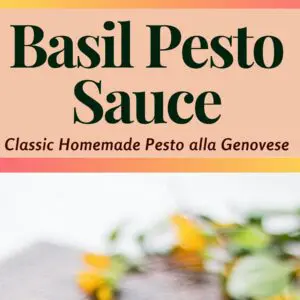
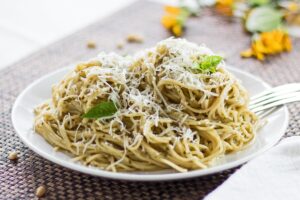
Comments
No Comments